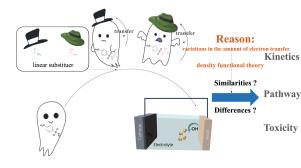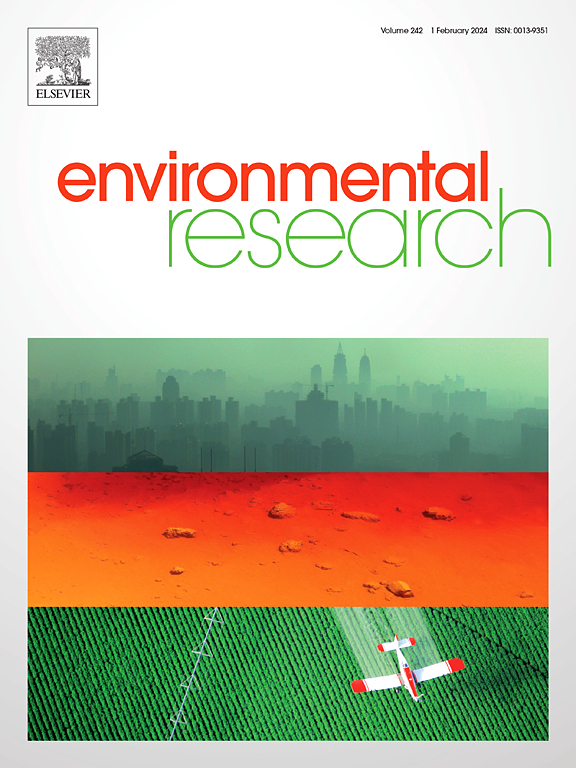New insight into linear substituents influencing electrooxidation treatment of sulfonamide antibiotics: Linking kinetics, pathways, toxicity, and active species with density functional theory
IF 7.7
2区 环境科学与生态学
Q1 ENVIRONMENTAL SCIENCES
引用次数: 0
Abstract
Linear substituents, despite their simpler structures compared to heterocyclic ones, exhibit distinct chemical behaviors. Using sulfacetamide (SAM) and sulfaguanidine (SGD) as model compounds, we assessed the impact of these substituents on degradation efficiency, active species identification, reaction pathways, and intermediate toxicity during electrooxidation in water. Through density functional theory, we elucidated the mechanisms, focusing on electronic structural changes and interactions with active species. Notably, the acetyl group in SAM (0.1016) acquired more electrons than the guanidyl group in SGD (0.0281), resulting in SAM having a higher free energy change () compared to SGD (). This difference makes SAM less likely to undergo direct electron transfer and less reactive towards hydroxyl radical addition, leading to slower degradation rates. The applied potential notably increased SAM’s sensitivity to hydroxyl radicals. Both the highest occupied molecular orbital (HOMO) and lowest unoccupied molecular orbital (LUMO) were contributed by the parent fragment, facilitating electrophilic reactions mainly on the aniline part. Seventeen intermediate products and three major transformation pathways were identified, emphasizing aniline group destruction before discharge. This research enhances understanding of the degradation and environmental fate of sulfonamides, providing valuable insights for optimizing pollutant degradation and discharge reduction.

影响磺胺类抗生素电氧化处理的线性取代基的新见解:利用密度泛函理论将动力学、途径、毒性和活性物种联系起来。
尽管线性取代基与杂环取代基相比结构更简单,但却表现出不同的化学行为。我们以磺乙酰胺(SAM)和磺胺脒(SGD)为模型化合物,评估了这些取代基在水中电氧化过程中对降解效率、活性物种识别、反应途径和中间体毒性的影响。通过密度泛函理论,我们阐明了其机理,重点是电子结构变化以及与活性物种的相互作用。值得注意的是,与 SGD(ΔG=9.59kcal/mol)相比,SAM(0.1016)中的乙酰基比 SGD(0.0281)中的鸟苷基获得了更多的电子,从而导致 SAM 具有更高的自由能变化(ΔG=15.06kcal/mol)。这种差异使得 SAM 不容易发生直接电子转移,对羟基自由基加成的反应性也较低,从而导致降解速度减慢。所施加的电势明显增加了 SAM 对羟自由基的敏感性。最高占位分子轨道(HOMO)和最低未占位分子轨道(LUMO)均由母体片段贡献,主要促进了苯胺部分的亲电反应。研究确定了 17 种中间产物和三种主要转化途径,强调了苯胺基团在放电前的破坏作用。这项研究加深了人们对磺胺类化合物的降解和环境归宿的了解,为优化污染物降解和减少排放提供了宝贵的见解。
本文章由计算机程序翻译,如有差异,请以英文原文为准。
求助全文
约1分钟内获得全文
求助全文
来源期刊

Environmental Research
环境科学-公共卫生、环境卫生与职业卫生
CiteScore
12.60
自引率
8.40%
发文量
2480
审稿时长
4.7 months
期刊介绍:
The Environmental Research journal presents a broad range of interdisciplinary research, focused on addressing worldwide environmental concerns and featuring innovative findings. Our publication strives to explore relevant anthropogenic issues across various environmental sectors, showcasing practical applications in real-life settings.
 求助内容:
求助内容: 应助结果提醒方式:
应助结果提醒方式:


